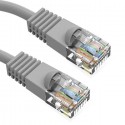✅ 100% PURE COPPER - Cables4sure Ethernet Patch Cable are made of 100% pure copper wire
✅ GOLD PLATED CONNECTORS - 50-micron gold-plated contacts for high-speed data transfer and corrosion resistance
✅ EXTRAORDINARY PERFORMANCE - With speeds of up to 1 Gbps, our 350 MHZ UTP CAT5E patch cable provides a high-speed, fast data transfer for server applications, cloud storage, gaming, PoE (Power over Ethernet), video chatting, online high definition video streaming and more.
✅ PREMIUM QUALITY - Meets or exceeds Category 5E performance in compliance with the TIA/EIA* T-568B standard wiring. UL/cUL Listed. RoHS.
Specification:
- UTP (Unshielded Twisted Pair) 24AWG Stranded Conductor
- 100% Pure Bare Copper Wire
- 50µm Gold Plated Contacts
- Protective Boot, Snagless Cable Boot Protects the Plug Retaining Pin
- TIA/EIA* T-568B Standard Wiring
- UL/cUL Listed
- RoHS
- Fully Compliant with UL Code 444 and National Electrical Code TIA-568-C.2 fire and Safety Standards
Applications:
-1000 BASE-T; 100 BASE-T; 10 BASE-T (IEEE 802.3)
-4/16 Mbps Token Ring (IEEE 802.5); 100 VG-Any LAN
-100 Mbps TP-PMD (ANSI X3T9.5); 55/155 Mbps ATM
-Voice
-Cat5e cable designed For: Network Adapters, Hubs, Switches, Routers, DSL/Cable Modems, Patch Panels and other twisted-pair applications
-All Cables4sure Cat5e Ethernet cable exceeds Category 5e cables specifications
-Wired: EIA/TIA 568 B.2-10-Verified for Gigabit Ethernet
-Supports IP Cameras
-Power over Ethernet (PoE) Compatible
-Fully tested to 350 MHz
Cat5e Patch Cables Questions & Answers
What is a Cat5e patch cable?
A Cat5e patch cable is a type of network cable that is used to connect devices in a local area network (LAN). It is designed to support up to 1000 Mbps (1 Gigabit) data transfer speeds and has four twisted pairs of copper wires.
What is the difference between Cat5 and Cat5e patch cables?
Cat5e patch cables are an upgraded version of Cat5 cables, with improved specifications for crosstalk and bandwidth. Cat5e cables are capable of supporting higher data transfer speeds and have better signal quality than Cat5 cables.
What is the maximum length of a Cat5e patch cable?
The maximum length of a Cat5e patch cable is 100 meters (328 feet) before signal loss and degradation may occur.
Can Cat5e patch cables be used for PoE (Power over Ethernet) applications?
Yes, Cat5e patch cables can be used for PoE applications. However, it is important to ensure that the cable is rated for the amount of power being delivered over the cable.
Can Cat5e patch cables be used for outdoor applications?
No, Cat5e patch cables are not designed for outdoor use and should not be used in environments where they may be exposed to moisture or extreme temperatures. Outdoor-rated Ethernet cables should be used instead.
Can Cat5e patch cables be used for gaming?
Yes, Cat5e patch cables are suitable for gaming, as they provide fast and reliable data transfer speeds for online gaming.
Can Cat5e patch cables be used for video streaming?
Yes, Cat5e patch cables are suitable for video streaming applications, as they can handle high data transfer rates required for high-quality video streaming.
Are all Cat5e patch cables the same?
No, not all Cat5e patch cables are the same. They can vary in terms of quality, shielding, and construction. It is important to choose a high-quality cable that meets the required specifications for the intended application.
We at Cables4sure.com sell only high quality copper Cat5e patch cables.
Can Cat5e patch cables be used in a Cat6 network?
Yes, Cat5e patch cables can be used in a Cat6 network, but they will not be able to support the higher data transfer speeds of Cat6 cables. It is recommended to use Cat6 cables for optimal performance in a Cat6 network.
How do I test a Cat5e patch cable?
You can test a Cat5e patch cable using a network cable tester, which can check for continuity, shorts, and other faults in the cable.
Should I use booted on unbooted Cat5e patch cable?
A booted Cat5e patch cable has a protective boot or cover at the end of the connector, which provides extra strain relief and protection for the cable. The boot helps to prevent the cable from being damaged by bending or pulling at the connector end.
An unbooted Cat5e patch cable does not have this protective cover, leaving the exposed connector susceptible to damage if the cable is bent or pulled too hard.
In general, if you expect to move or adjust your network cables frequently, or if you're in an environment where there's a higher risk of damage, then a booted Cat5e patch cable is recommended.
What is the difference between shielded and unshielded Cat5e patch cable?
The main difference between shielded and unshielded Cat5e patch cables is the presence of a shielding layer that surrounds the wires inside the cable.
Unshielded Cat5e cables, also known as UTP (Unshielded Twisted Pair), do not have any shielding layer and rely on the twisted pair design to reduce electromagnetic interference (EMI) and radio frequency interference (RFI). They are less expensive and more flexible than shielded cables, making them a popular choice for most applications.
Shielded Cat5e cables, on the other hand, have a layer of shielding around the wires inside the cable to provide additional protection against EMI and RFI.
Shielded Cat5e cables are generally more expensive than unshielded cables, but are ideal for environments with high levels of EMI and RFI, such as industrial settings or areas with high-powered electrical equipment.








